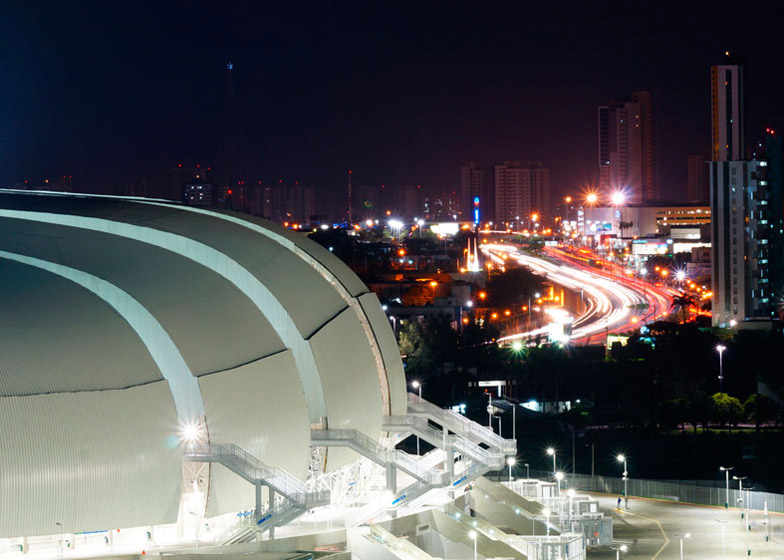Twenty huge aluminium petals fold around this 42,000-seat stadium that sports architecture firm Populous has completed in Rio Grande do Norte, Brazil, ahead of the FIFA World Cup kicking off this summer (+ slideshow).
Arena das Dunas is one of six new stadiums constructed for the international football tournament in 2014 and will be used to host four group stage matches in the city of Natal. It also serves as a new home stadium for local football clubs ABC FC and América de Natal.
Populous gave the stadium a steel truss structure made up of petal-shaped modules. Clad externally with aluminium tiles, these elements provide an asymmetric form intended to reference the sand dune landscape surrounding the city.
Translucent slices of polycarbonate fill the gaps between each petal, allowing more natural light to penetrate the stadium.
"We have designed a stadium and a masterplan that showcases the aesthetics of the beautiful surrounding area of das Dunas and will create a great atmosphere for the World Cup 2014," said Populous senior principal Christopher Lee, who led the project.
The stadium can seat 42,000 spectators, with the first row of stands just 15 metres away from the action. Up to 10,600 of these seats can be temporarily removed if necessary, plus four VIP lounges each create private viewing areas for 1000 guests.
The species of grass used for the pitch was selected for its suitability to the region's hot climate. It can be irrigated using recycled rainwater, collected from the roof as part of an integral drainage system.
Once the tournament is over, the building is expected to host other sports events, music concerts and trade shows. It is also surrounded by a 22,000-square-metre plaza that could become a centre for activities.
"The arena is in the city centre and after the World Cup we can set up a commercial area between the access ways," said stadium director Charles Maia. "Since the beginning, the arena was designed as a multipurpose venue that can be used year-round. Our goal is to make it profitable."
Arena das Dunas was officially inaugurated at the end of January and is one of four all-new stadiums designed for the FIFA World Cup 2014. These will join two older venues that have been completely rebuilt and six others that have undergone extensive renovation.
Here's a project description from Populous:
Populous designed Arena das Dunas officially opened ahead of 2014 World Cup
The Arena das Dunas in Natal, Rio Grande do Norte, which will host four group stage matches during the 2014 FIFA World Cup Brazil, has been inaugurated by President Dilma Rousseff.
The world's leading sports architecture practice, Populous, designed Arena das Dunas including the landscape and masterplan of the surrounding areas. The venue, which was inspired by the coastal city of Natal's sand dune landscape, has a capacity of 42,000 with 10,600 removable seats and has been delivered on time.
The Dunas Arena is designed to be a multipurpose venue. The main stadium will host sports events, trade shows and concerts, and the stadium's 22,000m2 outdoor plaza will also host events.
The first matches at the stadium took place on 26 January when the state of Rio Grande do Norte's main soccer teams faced each other in a double round: América-RN vs. Confiança-SE for the Northeast Cup, and ABC vs. Alecrim for the Rio Grande do Norte State Championship.
The local soccer clubs ABC and América have signed an agreement with the Dunas Arenas management consortium to use the venue for their home games for the next 20 years.
Arena Design
The arena's design is unique. Its facade and roof are integrated and made up of 20 petal-shaped modules, designed to be higher on one of the stadium's sides, giving the impression that the sand dunes – which are common in the region – are moving. The design also enables more ventilation and light to come into the stadium.
The petal-shaped structures of the roof are made of steel trusses, covered on the outside with aluminium tiles, with thermal and acoustic insulation. Internally, they are coated with a PVC prestressed membrane. The parts are joined by translucent polycarbonate, which allows light to come through.
The Dunas Arena's roof was also designed to capture rainwater. Gutters collect the water and take it to nine tanks below the lower stands. As a result, up to 3,000 cubic meters may be captured and reused in the lavatories and for irrigating the pitch.
Fans going to matches and events at the stadium will notice a new standard of comfort and safety. In total, there are 21 access ramps to reach each of the four stadium levels, in addition to elevators that connect the indoor car park directly with the 39 boxes. The Dunas Arena also has four lounges that can accommodate up to 1,000 people, 25 food and drink kiosks, as well as 30 restrooms.
There are four types of seats, identifiable by varying shades of blue: general public, hospitality, VIP and Executive VIP. In addition, 521 seats are reserved for people with disabilities.
A security team in the arena's command and control centre is able to monitor images recorded by 200 cameras with facial-recognition capability in the ground's external and internal areas. The PA system is integrated with the stadium's two 64 square metre screens, allowing for information and match statistics to be clearly displayed to the crowd.
Players will also notice improved match conditions. The Bermuda Tifton 419 grass species used for the pitch is ideal for the region's hot climate, and the drainage system allows for matches to be played even on extremely rainy days.
With the first row of stands only 15m away from the pitch, fans will be close to the action. In addition, the arena's lighting system, which uses 306 floodlights, provides uniform and consistent visibility, eliminating shadows and facilitating TV broadcasts using Full HD technology.







